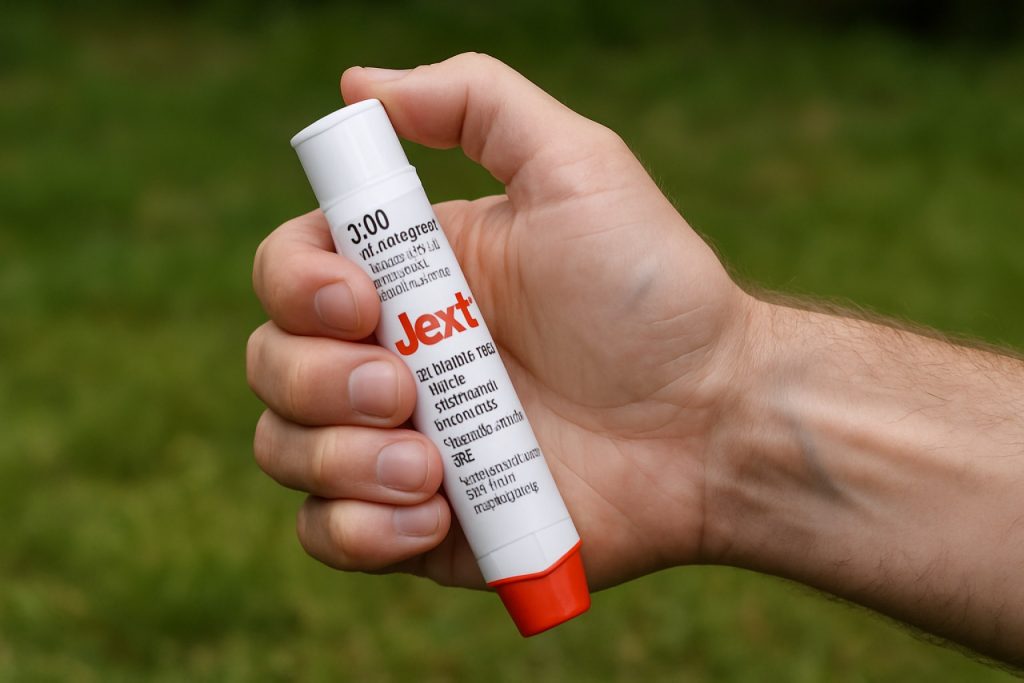
Unlocking the Power of the Jext Autoinjector: How This Life-Saving Device Transforms Emergency Allergy Management. Discover the Science, Safety, and Real-World Impact Behind Jext.
- Introduction to the Jext Autoinjector
- Mechanism of Action: How Jext Delivers Epinephrine
- Indications and Approved Uses
- Comparative Analysis: Jext vs. Other Autoinjectors
- Design Features and User Experience
- Clinical Efficacy and Safety Profile
- Guidelines for Prescription and Patient Training
- Storage, Shelf Life, and Maintenance
- Challenges, Limitations, and Reported Issues
- Future Developments and Innovations in Autoinjector Technology
- Sources & References
Introduction to the Jext Autoinjector
The Jext autoinjector is a medical device designed for the emergency treatment of severe allergic reactions, specifically anaphylaxis. Anaphylaxis is a rapid-onset, potentially life-threatening allergic response that can be triggered by various allergens, including foods, insect stings, medications, or latex. The Jext autoinjector delivers a pre-measured dose of adrenaline (epinephrine), which is the first-line treatment for anaphylactic reactions. Adrenaline works by rapidly reversing the symptoms of anaphylaxis, such as airway constriction, low blood pressure, and swelling, thereby providing critical time for the patient to seek further medical attention.
Jext is manufactured and distributed by ALK, a global pharmaceutical company specializing in allergy immunotherapy and related products. ALK is recognized for its commitment to improving the management of allergies and providing innovative solutions for patients at risk of severe allergic reactions. The Jext autoinjector is available in different dosage strengths, typically 150 micrograms for children and 300 micrograms for adults and adolescents, ensuring appropriate dosing based on patient age and weight.
The device is designed for ease of use, with clear instructions and a simple activation mechanism that allows patients or caregivers to administer the injection quickly and effectively, even in high-stress situations. The Jext autoinjector is intended for intramuscular injection, usually into the outer thigh, and can be administered through clothing if necessary. Its portability and user-friendly design make it a critical component of emergency preparedness for individuals diagnosed with severe allergies.
Jext is approved for use in several countries and is included in national guidelines for the management of anaphylaxis. Healthcare professionals typically prescribe Jext to patients with a known risk of anaphylaxis, and patients are advised to carry the device with them at all times. Training in the correct use of the autoinjector is essential, and resources are provided by both healthcare providers and the manufacturer to ensure users are confident in administering the medication when needed.
The importance of devices like the Jext autoinjector is underscored by the increasing prevalence of allergies worldwide and the need for rapid intervention in emergency situations. By providing immediate access to life-saving medication, Jext plays a vital role in reducing the morbidity and mortality associated with anaphylactic reactions.
For more information about the Jext autoinjector and its manufacturer, visit ALK.
Mechanism of Action: How Jext Delivers Epinephrine
The Jext autoinjector is a medical device designed for the rapid, intramuscular administration of epinephrine (adrenaline) in emergency situations such as anaphylaxis. Its mechanism of action is centered on both the pharmacological effects of epinephrine and the device’s engineered delivery system, which ensures prompt and effective drug administration.
Upon activation, the Jext autoinjector delivers a pre-measured dose of epinephrine through a spring-loaded needle. The device is designed for single-use and is intended for self-administration or administration by a bystander. The user removes the safety cap and presses the black tip firmly against the outer thigh, even through clothing if necessary. This action triggers the internal spring mechanism, causing the concealed needle to penetrate the muscle and inject the epinephrine solution rapidly.
The intramuscular route is critical for the rapid absorption of epinephrine, which is essential in life-threatening allergic reactions. Once injected, epinephrine acts on alpha and beta-adrenergic receptors throughout the body. Stimulation of alpha-adrenergic receptors leads to vasoconstriction, which helps to counteract the severe hypotension and tissue swelling associated with anaphylaxis. Simultaneously, activation of beta-adrenergic receptors results in bronchodilation, reduced mediator release from mast cells and basophils, and increased cardiac output. These combined effects work to reverse the symptoms of anaphylaxis, including airway constriction, low blood pressure, and hives.
The Jext autoinjector is manufactured and distributed by ALK, a global pharmaceutical company specializing in allergy immunotherapy and emergency treatments for severe allergic reactions. The device is available in two dosages—150 micrograms and 300 micrograms—allowing for appropriate dosing based on patient age and body weight. The design of the Jext autoinjector emphasizes ease of use, with clear instructions and audible clicks to confirm activation, reducing the risk of user error during high-stress situations.
The reliability and effectiveness of the Jext autoinjector’s delivery mechanism are supported by regulatory approvals and clinical guidelines, which recommend intramuscular epinephrine as the first-line treatment for anaphylaxis. The device’s engineering ensures that the medication is delivered quickly and efficiently, maximizing the chances of a positive outcome in emergency scenarios. For more information about the Jext autoinjector and its mechanism, refer to the official resources provided by ALK and regulatory authorities such as the European Medicines Agency.
Indications and Approved Uses
The Jext autoinjector is a pre-filled, single-use device designed for the emergency treatment of severe allergic reactions (anaphylaxis). Anaphylaxis is a rapid-onset, potentially life-threatening hypersensitivity reaction that can occur in response to allergens such as foods, insect stings, medications, or other triggers. The active ingredient in Jext is adrenaline (also known as epinephrine), which acts quickly to reverse the symptoms of anaphylaxis by constricting blood vessels, relaxing airway muscles, and reducing swelling and hives.
Jext is indicated for individuals who are at risk of, or have a history of, anaphylactic reactions. The device is intended for immediate self-administration or administration by a caregiver in emergency situations, prior to the arrival of medical professionals. The use of Jext is not limited by age; it is available in two dosage strengths: 150 micrograms for children weighing 15–30 kg, and 300 micrograms for adults and children over 30 kg. The selection of the appropriate dose is based on the patient’s body weight and clinical guidelines.
The primary approved use of Jext is the emergency management of anaphylaxis, regardless of the underlying cause. This includes anaphylactic reactions triggered by:
- Food allergens (e.g., peanuts, tree nuts, shellfish, milk, eggs)
- Insect venom (e.g., bee or wasp stings)
- Medications (e.g., antibiotics, non-steroidal anti-inflammatory drugs)
- Latex or other allergens
- Idiopathic anaphylaxis (where the trigger is unknown)
Jext is not intended for the treatment of mild allergic reactions or asthma attacks that are not associated with anaphylaxis. It is also not a substitute for immediate medical attention; after administration, patients are advised to seek emergency medical care, as further observation and treatment may be necessary. The device is designed for use in community settings, such as schools, workplaces, and homes, and is often prescribed to individuals with known severe allergies as part of their emergency action plan.
Jext is approved and regulated in the European Union and the United Kingdom, with its safety, efficacy, and indications overseen by national medicines agencies such as the European Medicines Agency and the Medicines and Healthcare products Regulatory Agency. These authorities provide guidance on the appropriate use of adrenaline autoinjectors and ensure that products like Jext meet stringent standards for emergency allergy management.
Comparative Analysis: Jext vs. Other Autoinjectors
The Jext autoinjector is a pre-filled, single-use device designed for the emergency treatment of severe allergic reactions (anaphylaxis). It is one of several adrenaline (epinephrine) autoinjectors available in Europe, alongside alternatives such as EpiPen and Emerade. A comparative analysis of Jext versus other autoinjectors involves evaluating device design, dosage options, usability, regulatory status, and availability.
In terms of device design, Jext features a compact, rectangular shape with clear labeling and a visible window to confirm the presence of the solution. The device is engineered for intuitive use, with a simple two-step activation process: remove the yellow cap and press the black tip firmly against the outer thigh. This design is comparable to the EpiPen, which also uses a two-step process, but differs from Emerade, which has a longer, pen-like shape and a single-step activation. The Jext device includes safety features to minimize accidental activation and needle exposure, similar to its competitors.
Regarding dosage options, Jext is available in two strengths: 150 micrograms for children and 300 micrograms for adults and adolescents. This mirrors the dosage options provided by EpiPen and Emerade, ensuring that prescribers can select an appropriate dose based on patient weight and age.
Usability is a critical factor in emergency situations. Studies and user feedback indicate that Jext’s clear instructions and audible click upon activation help reassure users that the injection has been delivered. The device is designed for use through clothing, which is standard among autoinjectors. Training devices are available for Jext, EpiPen, and Emerade, supporting patient and caregiver education.
In terms of regulatory status and availability, Jext is authorized for use in the European Union and the United Kingdom. It is manufactured by ALK-Abelló, a global pharmaceutical company specializing in allergy treatments (ALK-Abelló). EpiPen, produced by Viatris, is also widely available in Europe and globally (Viatris). Emerade, developed by Bausch + Lomb, has experienced periodic supply interruptions in some markets (Bausch + Lomb). All three devices are prescription-only medicines in most jurisdictions.
- Jext: Compact, two-step activation, available in 150/300 mcg, manufactured by ALK-Abelló.
- EpiPen: Widely recognized, two-step activation, 150/300 mcg, produced by Viatris.
- Emerade: Pen-like, single-step activation, 150/300/500 mcg, produced by Bausch + Lomb.
In summary, Jext offers a user-friendly, reliable alternative to other adrenaline autoinjectors, with comparable efficacy and safety profiles. The choice between devices often depends on patient preference, training, and local availability.
Design Features and User Experience
The Jext autoinjector is a medical device designed for the emergency treatment of severe allergic reactions (anaphylaxis) by delivering a pre-measured dose of adrenaline (epinephrine). Its design prioritizes rapid, reliable administration and ease of use, especially in high-stress situations where immediate action is critical. The device is manufactured by ALK, a global pharmaceutical company specializing in allergy treatment solutions (ALK).
A key design feature of the Jext autoinjector is its ergonomic, compact form factor. The device is cylindrical and lightweight, making it easy to carry in a pocket, bag, or emergency kit. The bright yellow or black color coding helps users quickly distinguish between different dosage strengths (typically 150 micrograms for children and 300 micrograms for adults), reducing the risk of dosing errors. The outer casing is robust, protecting the internal mechanism and medication from accidental damage or exposure to light.
The Jext autoinjector is engineered for intuitive, single-handed operation. The device incorporates a simple two-step activation process: first, the user removes the safety cap, and then presses the black tip firmly against the outer thigh. This action triggers the automatic injection of adrenaline through a concealed needle, which is only exposed during use, minimizing the risk of accidental needle sticks. Audible clicks signal both the activation and completion of the injection, providing reassurance that the dose has been delivered.
User experience is further enhanced by clear, printed instructions on the device itself, as well as accompanying patient information leaflets. These instructions are designed to be easily understood by both patients and caregivers, including those with limited medical training. The device is also suitable for use through clothing, which is crucial in emergency scenarios where time is of the essence.
Feedback from patients and healthcare professionals has influenced the design of the Jext autoinjector, with a focus on minimizing user error and maximizing reliability. The device includes a visible inspection window, allowing users to check the solution for clarity and expiration before use. Additionally, the safety cap is designed to be easily removed, even by individuals with reduced dexterity or in stressful situations.
Overall, the Jext autoinjector’s design reflects a commitment to safety, accessibility, and user confidence, supporting its role as a critical tool in the management of anaphylaxis (ALK).
Clinical Efficacy and Safety Profile
The Jext autoinjector is a pre-filled, single-use device designed for the emergency treatment of severe allergic reactions (anaphylaxis) in individuals at risk. It delivers a fixed dose of adrenaline (epinephrine) intramuscularly, which is the first-line treatment for anaphylaxis due to its rapid onset of action in reversing airway constriction, hypotension, and other life-threatening symptoms. The clinical efficacy and safety profile of the Jext autoinjector have been evaluated in both regulatory submissions and post-marketing surveillance.
Clinical studies and real-world evidence support the effectiveness of adrenaline autoinjectors, including Jext, in the management of anaphylactic episodes. The device is engineered to deliver a precise dose (either 150 micrograms or 300 micrograms) suitable for adults and children, depending on body weight. The intramuscular route, as provided by Jext, is recommended by leading allergy and immunology organizations due to its rapid absorption and reliable pharmacokinetics. The European Medicines Agency (EMA), which regulates medicines in the European Union, has authorized Jext based on data demonstrating that the device consistently delivers adrenaline within the therapeutic window required for effective anaphylaxis management.
The safety profile of Jext is consistent with that of adrenaline administered intramuscularly. Common adverse effects are generally mild and transient, including palpitations, anxiety, headache, dizziness, and tremor. These effects are attributable to the pharmacological action of adrenaline and are typically outweighed by the life-saving benefits in anaphylactic emergencies. Serious adverse events are rare and usually associated with incorrect administration or underlying cardiovascular disease. The Medicines and Healthcare products Regulatory Agency (MHRA), the UK’s regulatory authority, monitors the safety of Jext through pharmacovigilance systems and has not identified new safety concerns beyond those expected for adrenaline autoinjectors.
Jext is designed with safety features to minimize user error, such as a clear activation mechanism and needle protection after use. Training and patient education are emphasized by healthcare authorities to ensure correct administration, as improper use remains a significant risk factor for suboptimal outcomes. The British Society for Allergy & Clinical Immunology (BSACI), a leading professional body in the UK, recommends that patients and caregivers receive regular training in the use of adrenaline autoinjectors, including Jext, to maximize clinical efficacy and safety.
In summary, the Jext autoinjector demonstrates a favorable clinical efficacy and safety profile for the emergency treatment of anaphylaxis, supported by regulatory approvals and ongoing surveillance by recognized authorities. Its design and dosing align with international guidelines, and its benefits in life-threatening allergic reactions are well established.
Guidelines for Prescription and Patient Training
The Jext autoinjector is a pre-filled, single-use device designed for the emergency treatment of severe allergic reactions (anaphylaxis). Its prescription and patient training are governed by established clinical guidelines and regulatory recommendations to ensure safe and effective use.
According to the Medicines and Healthcare products Regulatory Agency (MHRA) and the National Health Service (NHS), Jext should be prescribed to individuals at risk of anaphylaxis, such as those with a history of severe allergic reactions to foods, insect stings, medications, or unknown triggers. The decision to prescribe is typically made by a specialist in allergy or immunology, or by a general practitioner with experience in managing anaphylaxis. Current guidelines recommend that patients at risk should be provided with two Jext autoinjectors at all times, as a second dose may be required if symptoms persist or recur before emergency medical help arrives.
Prescription of Jext must be accompanied by comprehensive patient education. The National Institute for Health and Care Excellence (NICE) and the British Society for Allergy & Clinical Immunology (BSACI) emphasize the importance of training patients, caregivers, and, where appropriate, school staff or colleagues. Training should include:
- Recognizing the signs and symptoms of anaphylaxis, such as difficulty breathing, swelling, hives, and hypotension.
- Instructions on the correct use of the Jext autoinjector, including removal from packaging, activation, and injection technique (typically into the outer thigh, through clothing if necessary).
- Guidance on post-injection actions, such as calling emergency services immediately after administration and lying the patient down with legs elevated unless breathing is difficult.
- Information on the need to carry two devices at all times and to check expiry dates regularly.
Healthcare professionals are encouraged to use demonstration devices and provide written and visual materials to reinforce training. Regular review and retraining are recommended, as studies have shown that retention of correct technique can decline over time. The Jext official website offers instructional videos and downloadable guides to support ongoing patient education.
In summary, the safe prescription and use of the Jext autoinjector rely on adherence to clinical guidelines, thorough patient training, and regular reinforcement to ensure preparedness in the event of an anaphylactic emergency.
Storage, Shelf Life, and Maintenance
The Jext autoinjector is a pre-filled, single-use device designed for the emergency treatment of severe allergic reactions (anaphylaxis). Proper storage, awareness of shelf life, and regular maintenance checks are essential to ensure the device’s effectiveness when needed.
Storage Conditions
Jext autoinjectors should be stored at room temperature, ideally between 15°C and 25°C (59°F to 77°F). Exposure to temperatures outside this range, especially freezing or excessive heat, can compromise the stability and efficacy of the adrenaline solution. The device should be kept in its original packaging to protect it from light, as exposure to sunlight or ultraviolet light may degrade the medication. It is important not to refrigerate or freeze the autoinjector, as this can damage the mechanism and the solution inside. The device should also be kept dry and away from moisture, which could affect the integrity of the autoinjector’s components.
Shelf Life and Expiry
Each Jext autoinjector is clearly marked with an expiry date on both the label and the carton. The typical shelf life is around 18 to 24 months from the date of manufacture, but users should always check the expiry date upon receipt and regularly thereafter. Using an expired autoinjector is not recommended, as the adrenaline may lose potency over time, reducing its effectiveness in an emergency. It is advisable to set reminders to check the expiry date periodically and to replace the device before it expires. Pharmacies and healthcare providers can assist in timely replacement and disposal of expired devices.
Maintenance and Inspection
Routine inspection of the Jext autoinjector is crucial. Users should periodically check the solution through the viewing window; it should appear clear and colorless. If the solution is discolored, cloudy, or contains particles, the device should not be used and must be replaced. The autoinjector should also be checked for any visible damage to the device or packaging. It is important not to test or tamper with the device, as it is designed for single use only. In addition, users should ensure that the safety cap remains in place until the device is needed.
For further guidance on storage, shelf life, and maintenance, users should consult the official patient information provided by the manufacturer or seek advice from healthcare professionals. The Jext autoinjector is manufactured and distributed by ALK, a global pharmaceutical company specializing in allergy treatment (ALK).
Challenges, Limitations, and Reported Issues
The Jext autoinjector is a pre-filled, single-use device designed to deliver a measured dose of adrenaline (epinephrine) for the emergency treatment of anaphylaxis. While it plays a critical role in life-saving interventions, several challenges, limitations, and reported issues have been identified in its use and distribution.
One of the primary challenges associated with the Jext autoinjector is user error during administration. Studies and regulatory reviews have highlighted that, in high-stress situations, patients or caregivers may struggle to correctly activate the device, potentially due to confusion about the instructions or the design of the autoinjector. This can result in incomplete or failed delivery of adrenaline, which may compromise patient outcomes. To address this, manufacturers have provided training devices and clear instructions, but the risk of misuse remains a concern, especially among children and untrained individuals (Medicines and Healthcare products Regulatory Agency).
Another limitation is the relatively short shelf life of the Jext autoinjector, typically around 12 to 18 months from the date of manufacture. This necessitates regular replacement to ensure efficacy, which can be burdensome for patients and healthcare systems. Expired devices may deliver suboptimal doses of adrenaline, reducing their effectiveness in emergencies. Additionally, there have been periodic supply shortages, leading to difficulties in obtaining replacements and raising concerns about continuous access for at-risk individuals (European Medicines Agency).
Device malfunctions, though rare, have also been reported. These include failures to activate, blocked needles, or leakage of the medication. Regulatory agencies have issued safety alerts and recalls in response to such incidents, emphasizing the importance of vigilance in quality control and post-market surveillance. For example, the Medicines and Healthcare products Regulatory Agency (MHRA) in the UK has periodically communicated updates regarding device reliability and user safety.
Furthermore, the Jext autoinjector is available in fixed doses (commonly 150 micrograms and 300 micrograms), which may not be optimal for all patient weights and ages. This limitation can pose challenges in pediatric populations or in individuals who fall outside standard dosing recommendations, potentially affecting the efficacy and safety of treatment.
In summary, while the Jext autoinjector is a vital tool for managing anaphylaxis, ongoing challenges include user error, limited shelf life, supply issues, occasional device malfunctions, and dosing constraints. Addressing these issues requires continued education, robust supply chain management, and ongoing monitoring by regulatory authorities such as the European Medicines Agency and Medicines and Healthcare products Regulatory Agency.
Future Developments and Innovations in Autoinjector Technology
The landscape of autoinjector technology is rapidly evolving, with significant implications for products like the Jext autoinjector, a device designed for the emergency treatment of anaphylaxis. As patient needs and regulatory expectations advance, manufacturers are focusing on innovations that enhance safety, usability, and reliability. The Jext autoinjector, produced by ALK-Abelló, is already recognized for its intuitive design and portability, but future developments are poised to further improve patient outcomes and user experience.
One key area of innovation is the integration of digital health technologies. Emerging prototypes and next-generation autoinjectors are exploring features such as Bluetooth connectivity, dose tracking, and integration with smartphone applications. These advancements aim to support adherence, provide reminders for device expiration, and facilitate communication with healthcare providers. Such features could be particularly beneficial for individuals at risk of anaphylaxis, ensuring timely administration and follow-up care.
Another focus is on improving the mechanical and ergonomic aspects of autoinjectors. Research and development efforts are directed toward reducing the force required for activation, minimizing injection pain, and ensuring consistent drug delivery across a wide range of environmental conditions. Enhanced needle-shielding mechanisms and clearer visual or audible cues are also being considered to reduce user error and increase confidence during emergency use.
Sustainability is becoming increasingly important in medical device design. Manufacturers, including those behind Jext, are investigating the use of recyclable materials and eco-friendly packaging to reduce environmental impact. This aligns with broader healthcare industry trends toward greener practices and regulatory encouragement for sustainable product development.
Regulatory bodies such as the European Medicines Agency and the Medicines and Healthcare products Regulatory Agency (MHRA) in the UK are also influencing innovation by updating guidelines for autoinjector safety, labeling, and post-market surveillance. These evolving standards drive manufacturers to adopt more rigorous testing and user-centered design approaches, ensuring that future iterations of devices like Jext meet the highest standards of efficacy and safety.
In summary, the future of the Jext autoinjector will likely be shaped by advances in digital integration, ergonomic design, sustainability, and regulatory compliance. These innovations are expected to further empower patients and caregivers, reduce risks associated with anaphylaxis, and support the broader goals of modern healthcare systems.
Sources & References
- ALK
- European Medicines Agency
- Medicines and Healthcare products Regulatory Agency
- ALK-Abelló
- Viatris
- Bausch + Lomb
- Medicines and Healthcare products Regulatory Agency (MHRA)
- National Health Service (NHS)
- National Institute for Health and Care Excellence (NICE)



